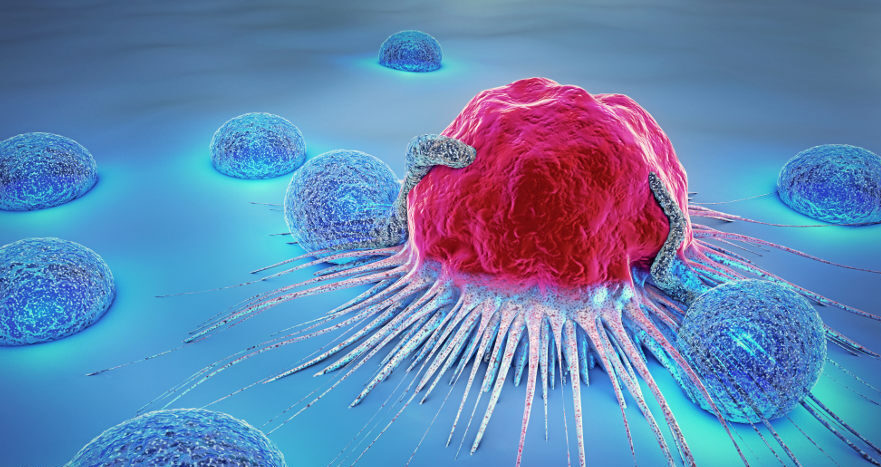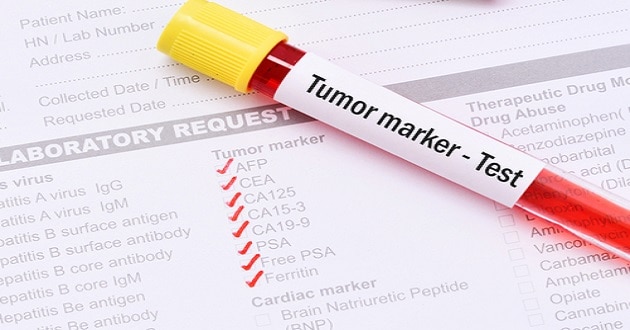Definicija tumora
Tumor je svaka nenormalna proliferacija ćelija u organizmu. Bilo koja ćelija u organizmu može podleći proliferaciji. Karakteristike tumorskih ćelija su:
- autonomni rast
- nediferenciranost i primitivna građa
- infiltrativni rast
- promenjen metabolizam
- sposobnost metastaziranja

Tumor markeri
Tumor markeri su supstance koje proizvode tumorske ćelije, ali ih mogu stvarati i zdrave, normalne ćelije. Proizvodi ih ili sam karcinom ili organizam pacijenta kao odgovor na prisustvo karcinoma, ali mogu biti i posledica nekog benignog poremećaja. Nalaze se unutar ćelija, a takođe cirkulišu i u krvi.
Idealan tumor marker bi bio:
- onaj koji ima dovoljnu specifičnost tj. prisutan je jedino kod pacijenata sa određenom vrstom karcinoma
- ima dovoljnu osetljivost-pojavljuje se u dovoljnoj količini u telesnim tečnostima i u ranim stadijumima bolesti
- da je njegova koncentracija u korelaciji sa veličinom tumorske ćelije koja ga sekretuje
- da se može detektovati u ranoj fazi bolesti tako da bi se stekla prednost u odnosu na razvoj bolesti
- da se lako određuje i da ne košta puno
Nažalost, ne postoji idealan tumor marker. Nijedan do sada poznat tumor marker nije 100% specifičan (jer se detektuje i kod zdravih osoba i kod osoba sa benignim oboljenjima), niti je 100% osetljiv (jer se ne može detektovati u svim stadijumima bolesti, posebno u početnom). I pored ovih “nedostataka”, tumor markeri se svakodnevno određuju u laboratorijskoj praksi i njihovo određivanje je dosta korisno.

Kada se određuju tumor markeri?
- kao pomoć pri postavljanju dijagnoze i proceni stadijuma bolesti
- u predviđanju toka bolesti
- u planiranju i praćenju terapije, predviđanju odgovora na terapiju i rezistenciju
- u praćenju toka bolesti i ranom otkrivanju recidiva
Uglavnom se ne koriste za dijagnozu i skrining. Karcinom se može potvrditi jedino biopsijom. Međutim, velika je uloga tumor markera u otkrivanju izvora primarnog karcinoma kod pacijenata bez prethodne istorije. Npr. kod žena gde je hirurški utvrđena ogromna tumorska masa u karlici i abdomenu, visok nivo CA 125 ukazuje na karcinom ovarijuma.
Šta treba znati kod određivanja tumor markera?
Pojedinačne vrednosti nisu od velikog značaja jer u raznim nemalignim stanjima dolazi do povećanja vrednosti tumor markera. Ova povećanja su prolazna. Povećane vrednosti koje su posledica kancera, ili perzistiraju ili kontinuirano rastu pri ponavljanim određivanjima. Upravo serijsko određivanje tumor markera obezbeđuje detekciju lažno pozitivnih vrednosti usled prolaznog povećanja. Da bi serijsko određivanje imalo smisla, mora se koristiti isti test i ako je moguće ista laboratorija.
Tumor markeri koji se koriste u kliničkoj praksi
Alfa-fetoprotein (AFP)
U zdravih odraslih osoba AFP je prisutan u minimalnim količinama ili ga nema.
Međutim, maligne ćelije karcinoma jetre, embrionalni tumori testisa, ovarijuma i uterusa intenzivno sintetišu i produkuju AFP. Najveća dijagnostička vrednost AFP je u potvrđivanju primarnog karcinoma jetre, a od značaja je i njegova primena kao pokazatelja efekta terapije nakon intervencije.
β-2-mikroglobulin (β-2MG)
Nivo β-2MG u zdravih osoba je obično konstantna, a povećava se postepeno saoštećenjem funkcije bubrega (obzirom da se ova supstanca normalno izlučuje glomerularnom filtracijom i kompletno razgrađuje u proksimalnim tublima).
Određivanje β-2MG kao tumor markera najčešće se koristi u proceni prognoze i praćenju terapije malignih oboljenja hematopoeznih organa i to kod onih bolesnika kod kojih ne postoji oštećenje funkcije bubrega.
β-humani horioni gonadotropin (β-HCG)
β-HCG normalno sintetiše placenta od 9. dana trudnoće pa na dalje.
Ovaj marker je od posebnog značaja u dijagnostici horiokarcinoma. Intenzivno se stvara u i u ćelijama malignih teratoma testisa i ovarijuma. Budući da maligni teratomi produkuju AFP i β-HCG, kod ovih tumora najčešće se uporedo određuju.
Karcinomembriogeni antigen (CEA)
Fiziološki se stvara u tkivu fetusa te je stoga prisutan u velikoj količini u fetalnoj krvi. Nakon rođenja nivo CEA opada, a u krvi zdrave odrasle osobe ga nemaili je prisutan u veoma niskim količinama. Određivanje CEA je od velikog značaja u potvrđivanju maligniteta pankreasa, bilijarnog trakta i kolona. Značajnu ulogu ima u praćenju terapije nakon uklanjanja tumora, gde nakon uspešne hirurške intervencije dolazi do rapidnog pada nivoa ovog tumor markera.
CA 15-3
CA 15-3 se koristi u dijagnostici karcinoma dojke, gde se u 80% slučajeva nalaze povišene vrednosti ovog tumorskog markera. Posebno je značajna primena ovog tumorskog markrea u postterapijskom praćenju, odnosno u ranoj detekciji recidiva i metastaza karcinoma dojke.
CA 19-9
Naziva se i gastrointenstinalnim kancerskim antigenom budući da ga intenzivno produkuju ćelije tumora gastrointenstinalnog trakta, posebno karcinom pankreasa i bilijarnog trakta. CA 19-9 se danas smatra markerom izbora u dijagnostici i diferencijalnoj dijagnozi karcinoma pankresa, a veliki značaj ima u praćenju efekta terapije tumora ovih lokaliteta. Primena ovog tumor markera je ograničena na bolesnike kod kojih ne postoji oštećenje jetre jer se u tim slučajevima mogu javiti lažno povišene vrednosti.
CA- 125
Stvara se u velikim količinama u ćelijama adenokarcinoma ovarijuma, a posebno je značajan u praćenju efekta terapije jer omogućava otkrivanje recidiva tumora znatno ranije u odnosu na druge metode. Povećanje CA-125 javlja se i kod nekacerogenih promena na jajniku.
CA 50
Koristi se za praćenje bolesnika sa karcinomom pankreasa. Koncentracija CA 50 može biti povišena i kod pacijenata sa benignim bolestima pankreasa i cirozom jetre.
CA 72-4
CA 72-4 se najviše izlučuje u serum pacijenata sa karcinomom želuca. Povišene vrednosti ovog tumor markera se mogu naći kod karcinoma kolona, pankreasa i jajnika. Pad koncentracije CA 72-4 nakon hirurške intervencije ukazuje da je maligno tkivo uklonjeno, dok je njegov nagli porast u serumu povezan sa povratkom bolesti ili metastazama.
Kalcitonin
Kalcitonin je hormon kog sintetišu parafolikularne ćelije (C ćelije) štitne žlezde. Povišene vrednosti kalcitonina se sreću kod pacijenata sa medularnim karcinomom štitne žlezde. Pogodan je za detekciju i praćenje toka bolesti kod pacijenata sa ovom vrstom karcinoma.
Citokeratin fragment 21-1 (Cyfra 21-1)
Koristi se za praćenje mirkocelularnog karcinoma pluća. Povišene vrednosti se mogu naći i drugim tipovima plućnog karcinoma. Ovaj marker može biti povišen i u benignim stanjima kakva su inflamacija i fibroza pluća.
Prostata specifičan antigen (PSA) i slobodan specifičan antigen (fPSA)
PSA je specifičan za prostatu, ali ne i za karcinom. Koristi se za detektovanje i praćenje karcinoma prostate. Pored ukupnog PSA, određuje se i slobodni PSA koji čini 10-40% vrednosti ukupnog PSA. Procenat slobodnog PSA u serumu pacijenata sa malignim tumorom se smanjuje paralelno sa porastom koncentracije ukupnog PSA. Umereno povišena koncentracija PSA u serumu prisuntna je kod benignih bolesti prostate (upala i hiperplazija prostate). Pored ukupnog PSA merenjem i slobodnog PSA i izračunavanjem odnosa fPSA/PSA omogućava se bolje razdvajanje pacijenata sa karcinomom prostate od bolesnika sa benignom hiperplazijom prostate. Ovaj tumor marker se pokazao veoma korisnim, kako za ranu dijagnozu, tako i za praćenje pacijenata sa malignim tumorom prostate.
Tireoglobulin (TG)
Tireoglobulin predstavlja glikoprotein koji se nalazi u štitnoj žlezdi, a u cirkulaciji se nalazi u vrlo malim količinama. Međutim, ukoliko maligni proces narušava strukturu štitne žlezde, tireoglobulin se pojačano oslobađa u krv i njegova koncentracija raste. Određivanje tireoglobulina kao tumorskog markera se koristi u dijagnostici karcinoma štitne žlezde.
Tkivni polipeptidni antigen (TPA)
TPA predstavlja keratinski antigen koji se nalazi u većini epitelnih ćelija, serumu i membranama tumorskih ćelija. Povišene vrednosti su nađene kod pacijenata sa karcinomom pluća, dojke, rektuma, jajnika i bešike. Iako nije specifičan za maligne tumore, može da se koristi kao sekundarni marker za praćenje pacijenata sa karcinomom mokraćne bešike.
Neuron specifična enolaza (NSE)
NSE predstavlja glikolitički enzim koji se nalazi u ćelijama centralnog i perifernog nervnog sistema. Aktivnost ovog enzima raste kod pacijenata sa neuroblastomom i karcinomom pluća malih ćelija. Povećana aktivnost NSE prisutna je i kod pacijenata sa malignim tumorima drugih organa (bubrega, testisa, pankreasa), melanomom.
Koncentracija ovog markera prati uspešnost terapije, proliferacije i prognozu bolesti pacijenata sa neuroblastomom i karcinomom pluća. Prihvaćen je kao marker izbora.
Prostatična kisela fosfataza (PAP)
U krvi zdravih osoba muškog pola se nalaze u neznatnoj količini. Aktivnost ovog enzima je povišena kod pacijenata sa karcinomom prostate, a izrazito je povišena u prisustvu metastaza. Specifičnost PAP je viša u odnosu na PSA, ali u ranom stadijumu bolesti PAP ima malu dijagnostičku osetljivost nego PSA. Nakon prostatektomije aktivnost PAP je nemerljiva, ali u slučaju recidiva ili metastaza njena aktivnost raste.
Povišena aktivnost PAP se sreće i kod bolesnika sa karcinomom testisa, leukemijom, limfomima, kao i u benignim bolestima prostate, osteoporozom, cirozom jetre i plućnom embolijom.
S-100
Normalno se nalazi u ćelijama tkiva.
Povišene vrednosti su prisutne u serumu pacijenata sa melanomom i udaljenim metastazama. Njegova koncentracija se određuje nakon operacije melanoma i nakon primenjene hemioterapije. Pošto porast i pad koncentracije prate remisiju i recidiv bolesti ili pojavu metastaza, S-100 se koristi kao tumor marker za praćenje pacijenata sa melanomom.
Antigen karcinoma skvamoznih ćelija (SCCA)
Lokalizovan je u citoplazmi malignih ćelija cerviksa i korpusa uterusa. Nivo SCCA u serumu raste kod pacijenata sa karcinomom skvamoznih ćelija cerviksa i korpusa uterusa i korelira sa stepenom bolesti. Klinički značaj je u prognozi i detektovanju metastaza cervikalnog i uterusnog karcinoma.
Povećane koncentracije SCCA mogu da se nađu i u karcinomima skvamoznih ćelija pluća, ezofagusa i anusa. Umereno povećane vrednosti se nalaze u nekim benignim stanjima: renalna isuficijencija i ginekološkim poremećajima.
Bence-Jones-ov protein (BJP)
Paraprotein koji sintetišu imunociti u nekim patološkim stanjima. Njegovo prisustvo u mokraći ukazuje na maligne promene imunocita. Koristi se kao marker izbora za dijagnozu ili praćenje bolesnika sa multiplim mijelomom.
Humani epididimis protein 4 (HE4)
HE4 je pouzdan marker rane detekcije i praćenja karcinoma ovarijuma. Normalno tkivo ovarijuma sekretuje male količine ovog proteina. Kada se ispitivanja koncentracije HE4 kombinuju sa ispitivanjem CA 125, znatno se povećava senzitivnost za detekciju karcinoma ovarijuma.
Visoka koncentracija HE4 sa visokom koncentracijom CA 125 u cirkulaciji ukazuje na karcinom ovarijuma, dok porast CA 125 bez porasta HE4 ukazuje na benigne promene ovarijuma. Porast HE4 bez porasta CA 125 ukazuje ili na ovarijalne ili na druge tipove karcinoma (npr. endomerijum).
Prostata kancer gen 3(PCA3)
PCA3 je prostata-specifičan gen koji je visoko eksprimiran u ćelijama karcinoma prostate.
To je novi, genetski parametar, koji se određuje iz prvog urina uzetog nakon digitalnog rektalnog pregleda i značajno doprinosi smanjenju broja nepotrebnih biopsija u postupku dijagnoze karcinoma prostate i povećanju pouzdanosti u postavljanju iste.
